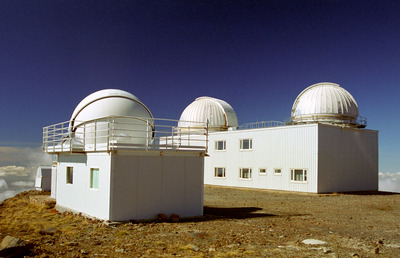about project
BOOTES-IR is the extension of the BOOTES experiment, which has been operating in Southern Spain since 1998, to the near-infrared (nIR). The goal is to follow up the early stage of the gamma ray burst (GRB) afterglow emission in the nIR, as BOOTES does already at optical wavelenghts. The scientific case that drives the BOOTES-IR performance is the study of GRBs with the support of spacecrafts like HETE-2, INTEGRAL and SWIFT (and GLAST in the future).

Given that the afterglow emission in both, the nIR and the optical, in the instances immediately following a GRB, is extremely bright (reached V = 8.9 in one case), it should be possible to detect this prompt emission at the nIR wavelengths too. Combined observations by BOOTES-IR and BOOTES-1 and BOOTES-2 since 2006 can allow for real time identification of trustworthy candidates to have a ultra-high redshift (z > 6). It is expected that, few minutes after GRB, the nIR magnitudes be H ~ 10-15, hence very high quality spectra can be obtained for objects as far as z = 10 by much larger ground based telescopes.

A significant fraction of observing time will be available for other scientific projects of interest, objects relatively bright and variable, like Solar System, brown dwarfs, variable stars, planetary nebulae, compact objects in binary systems and blazars.
BOOTES-IR team
A. J. Castro-Tirado (1), J. Gorosabel (1), A. de Ugarte Postigo (1), M. Jelínek (1), S. Vítek (1), P. Kubánek (2), R. Cunniffe (1), S. Castillo-Carrión (3), T. J. Mateo Sanguino (3), A. Riva (4), P. Conconi (4), V. di Caprio (4), F. Zerbi (4), P. Amado (1), C. Cárdenes (1), A. Claret (1), S. Guziy (), S. Martín-Ruiz (1), M. A. Sánchez (1), P. García Teodoro (5), J. Castro Cerón (), J. Díaz Verdejo (5), R. Hudec (2), J. M. López Soler (5), J. Á. Berná Galiano (7), J. Casares (8), J. Fabregat (9), P. Páta (10), C. Sánchez-Fernández (11), M. D. Sabau-Graziati (12), J. M. Trigo-Rodríguez (13) and F. Vitali (14)
- Instituto de Astrofísica de Andalucía (IAA-CSIC), P.O. Box 03004, E-18080, Granada
- Área de Ingenería Telemática (DETC), Universidad de Granada, Spain
- Real Instituto y Observatorio de la Armada (ROA) - San Fernando-Naval (Cádiz), Spain
- Escuela Politécnica Superior (DFITS-EPSA), Universidad de Alicante, Spain)
- Grupo de Astronomía y Ciencias del Espacio (GACE), Universidad de Valencia, Spain
- Fakulta Elektrotechnická, ÈVUT Praha, Czech Republic
- INTEGRAL Scientific Operations Centre, ESAC, Villafranca de Castillo, Madrid, Spain
- Instituto Nacional de Técnica Aerospacial (INTA), Torrejón de Ardoz, Madrid, Spain
- Instituto de Ciancias des Espacio (CSIC), Campus UAB, Bellaterra (Barcelona), Spain
- Osservatorio Astronomico di Roma
- INTEGRAL Scientific Data Center, Versoix, Switzerland
- Kalinenkov Astronomical Observatory, Nikolaev, Ukraine
- DARK Cosmology Center, Copenhagen, Denmark
- Institut d'Espacials de Catalunya (IEEC), Barcelona, Spain